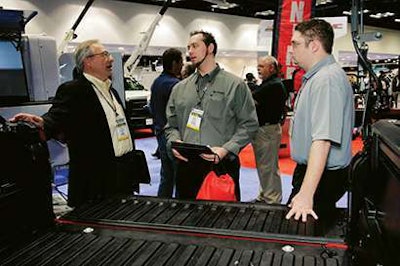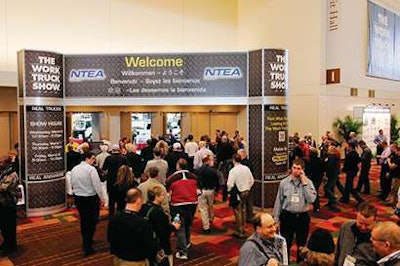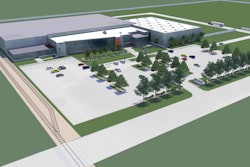
More than 10,000 work-truck industry pros headed to Indianapolis, Indiana, March 6-8 to see the 500,000 square feet of new equipment, vans and trucks at the National Truck Equipment Association’s (NTEA) 2013 Work Truck Show.
Jack Roberts, executive trucks editor, walked the floor, tested new equipment and got a feel for where things are headed. Here are his five main takeaways.
1. The sense is the economy is, in fact, recovering. It’s not recovering as fast as anyone would like – but things are getting better.
At Ford’s press conference to unveil the new Transit van, the company noted the average age of commercial vehicles in the United States now is 11 years old. A lot of fleets (and private owners) have been hanging on to their vehicles while the economy sorted itself out. And combined with the sluggish recovery, it seems to indicate a lot of people are soon going to be looking to purchase new vehicles.
2. The days of the Scooby-Doo Mystery Machine van are numbered. For years, we’ve seen stutter-steps from manufacturers who want to consolidate their design, production and supply chain capacities by introducing global vehicle platforms — i.e., sell the same vehicles they make for Europe and Asia here in the States.
The United States has stubbornly resisted this trend for many years now: The same box-style van that Scooby-Doo and his hippie, crime-busting friends cruised around in still dominates the market here. But if the new vehicle launches at this show are an indication, a sea change is now occurring.

Beyond Sprinter, this Work Truck Show saw new, Fiat-designed Ram commercial vans entering the market, the much-anticipated debut of Ford’s successful-in-Europe Transit van and Nissan’s stateside launch of its NV200.
The trend is undeniable: Manufacturers think their global solutions will work well here in the States, and fleets seem to be warming to these vehicles, as well.
3. Compact vans are a thing. Speaking of Nissan’s NV200, it seems that with fuel prices spiking once again, and general uncertainty being the norm when it comes to fuel these days anyway, compact vans are gaining traction in a big way.
Again, we have to give Ford props for leading the charge here with the successful stateside launch of the zippy, funky-yet-functional Transit Connect. They’ve now followed with the launch of the next-generation Transit Connect, as well as a new wagon version — both of which will likely prove to be highly attractive to small business owners and P&D fleets.
Nissan is entering this market in a big way, as well. Starting at $19,990, the new NV200 looks cool, is economical to operate and tough enough to be named the next New York City taxi cab.
All told, about 40,000 “compact vans” were sold in the country last year. And I believe that as fuel prices rise, that number will grow – perhaps significantly. I have to think Fiat, Volkswagon, Toyota and more than a few other global players are watching this market with interest.
4. Hybrids aren’t working out on big rigs. At the Green Truck Summit that opened the Work Truck Show, several heavy-duty truck manufacturers noted interest in hybrids has fallen off dramatically during the past couple of years.
It should be noted in select applications – particularly bucket trucks (and other vehicles that need a source of electrical power to perform work) and refuse – hybrids still make sense.

Additionally, battery maintenance and replacement is turning out to be more expensive than originally thought. And – for all these reasons – the trucks are proving difficult to move when it’s time to sell and replace them.
At the same time, however, it appears that hybrids are gaining interest and greater adoption in medium-duty applications – particularly in the van market. Here, hybrids seem to make a lot more sense. The systems are more affordable: XL Hybrids showed me a system that can be purchased and installed on an E-Series Ford van for less than $10,000. Even better, the inherent urban, stop-and-start nature of the work many of these vehicles perform is ideally suited to maximize fuel economy, which translates into a much-faster ROI.
It’s pretty clear that hybrids still have a lot of potential in heavy-duty applications. But barring some changes in acquisition and maintenance costs, it looks now like we may see them regulated to niche vehicles and applications until those shortcomings are addressed.
5. Solar power is coming. The stage is now set for another revolution in renewable energy in trucking. At a press conference, a company called eNow showed a new solar-strip/energy management system that I think shows fleets an easy way to power APUs, lift gates and other electric applications on commercial vehicles.
Solar power has been mocked for years – and still is in some venues. But when you consider the available surface area of all the truck-trailers running around in this country, and the increasing need for auxiliary electric power those trailers – and the tractors and trucks that pull them – need, this new movement is kind of a no brainer.
A new generation of tough, durable solar-panel strips can now be linked to smart energy management systems to provide lots of storable electrical power – more than enough, in fact, to keep a reefer cooled down or a driver’s APU kicking out BTUs on a cold winter night.
This push is in its infancy at the moment, but I for one would not be the least bit surprised to look down from an airplane window five or 10 years from now and see the highways below glittering like rivers of diamonds from all of the solar-panel-covered trailers rolling along below. It’s a good idea, and I think it’s going to catch on quickly.










